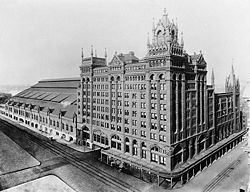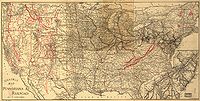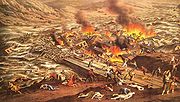
George Brooke Roberts
Encyclopedia
George Brooke Roberts was a civil engineer and the 5th president of the Pennsylvania Railroad
(1880–96).
.jpg) Born on Pencoyd, his family's ancestral farm in Bala Cynwyd, Pennsylvania
Born on Pencoyd, his family's ancestral farm in Bala Cynwyd, Pennsylvania
, Roberts graduated from Rensselaer Polytechnic Institute
in 1849, and taught there for 2 years before becoming a rodman for the Pennsylvania Railroad (PRR). From 1852 he worked for the Philadelphia & Erie Railroad, returning to the PRR in 1862 as assistant to the president, J. Edgar Thomson. Roberts oversaw the construction of bridges and other engineering work, including the Connecting Railway Bridge
over Schuylkill River
in Philadelphia (attributed to John A. Wilson
, 1866–67) for a PRR subsidiary. He became a PRR vice-president in 1869, and succeeded Thomas A. Scott as PRR president in 1880.
 Early in Roberts's tenure the PRR completed Broad Street Station
Early in Roberts's tenure the PRR completed Broad Street Station
in Philadelphia, a seminal event in the city's history. Prior to this, PRR locomotives did not cross the Schuylkill River
into Center City
, but deposited passengers at West Philadelphia Station (32nd Street). Construction of a bridge and a 10-block viaduct between the river and Broad Street—the "Chinese Wall" -- carried the PRR tracks 2 stories above street level and into the Wilson Brothers
-designed station. With the 1871 decision to build Philadelphia's City Hall at Broad & Market Streets and the 1881 opening of the PRR station, the center of Philadelphia's business district rapidly moved westward. The station's location at the heart of the city made commuting via the PRR practical, fueling suburban growth (especially on the Main Line). A dozen years later, the PRR hired Frank Furness
to greatly expand Broad Street Station, turning it into the largest station building in the world.
. The "Welsh Barony" made up much of the Philadelphia suburban region now known as the Main Line, named for the Main Line of Public Works
, a cross-state rail/canal system that ran through it.
Roberts was the 6th proprietor of Pencoyd, and proud of his Welsh heritage. He chose Welsh names for some of the suburban PRR stations, including Bala and Cynwyd.
Roberts hired Frank Furness
to expand the family house at Pencoyd, and in 1890 the architect designed the PRR's second Bryn Mawr Hotel (now the Baldwin School
). Theophilus Parsons Chandler, Jr.
designed St. Asaph's Church, at the southern end of Roberts's farm. Author Nathaniel Burt quipped: "The Church of St. Asaph, dedicated, as the saying goes, to the Glory of God and the convenience of the Roberts family."
T. Williams Roberts became the 7th proprietor of Pencoyd, removed all the Frank Furness
alterations to the house, and lived there until his death in 1962. Pencoyd was sold, and demolished by developers in 1964. Office buildings and a Saks Fifth Avenue
department store now occupy the City Avenue site.
 George Brooke Roberts's first major accomplishment as PRR president was the 1881 purchase of a majority stake in the Philadelphia, Wilmington & Baltimore Railroad, providing a direct PRR line from New York City (actually Jersey City, New Jersey
George Brooke Roberts's first major accomplishment as PRR president was the 1881 purchase of a majority stake in the Philadelphia, Wilmington & Baltimore Railroad, providing a direct PRR line from New York City (actually Jersey City, New Jersey
, until 1911) to Washington, DC. Amtrak
uses this same route today.
Competition between the PRR and the New York Central Railroad
was fierce. In response to William H. Vanderbilt and Andrew Carnegie
beginning construction of a railroad across Pennsylvania to directly compete with the PRR, Roberts bought up land on the west side of the Hudson River
to directly compete with the NYCR on the east side. J. P. Morgan
saw this as wasteful competition and negotiated an 1885 truce between Vanderbilt and Roberts, in which each abandoned the competing line. Vanderbilt's line became the right-of-way for the Pennsylvania Turnpike
, and Roberts's for the Palisades Parkway
.
 Under Roberts the PRR introduced in 1887, direct service from New York City to Chicago, Illinois. The Pennsylvania Limited made the trip in 24 hours by way of Philadelphia, Harrisburg and Pittsburgh
Under Roberts the PRR introduced in 1887, direct service from New York City to Chicago, Illinois. The Pennsylvania Limited made the trip in 24 hours by way of Philadelphia, Harrisburg and Pittsburgh
. By 1902, an express train was introduced, the Pennsylvania Special, that cut the time to 20 hours.
The 1889 Johnstown Flood
occurred during Roberts's presidency. The PRR's Stone Bridge
over the Conemaugh River in Johnstown acted as a dam, trapping debris that covered 30 acres (and soon caught fire). The PRR was a major participant in the rescue effort. It reopened its line to Pittsburgh within 3 days, and was the primary means by which relief workers and provisions reached the victims of the disaster. The Stone Bridge still stands today.
Pennsylvania Railroad
The Pennsylvania Railroad was an American Class I railroad, founded in 1846. Commonly referred to as the "Pennsy", the PRR was headquartered in Philadelphia, Pennsylvania....
(1880–96).
.jpg)
Bala Cynwyd, Pennsylvania
Bala Cynwyd is a community in Lower Merion Township which is located on the Main Line in southeastern Pennsylvania, bordering the western edge of Philadelphia at US Route 1 . It was originally two separate towns, Bala and Cynwyd, but is commonly treated as a single community...
, Roberts graduated from Rensselaer Polytechnic Institute
Rensselaer Polytechnic Institute
Stephen Van Rensselaer established the Rensselaer School on November 5, 1824 with a letter to the Rev. Dr. Samuel Blatchford, in which van Rensselaer asked Blatchford to serve as the first president. Within the letter he set down several orders of business. He appointed Amos Eaton as the school's...
in 1849, and taught there for 2 years before becoming a rodman for the Pennsylvania Railroad (PRR). From 1852 he worked for the Philadelphia & Erie Railroad, returning to the PRR in 1862 as assistant to the president, J. Edgar Thomson. Roberts oversaw the construction of bridges and other engineering work, including the Connecting Railway Bridge
Pennsylvania Railroad Connecting Bridge
Pennsylvania Railroad, Connecting Railway Bridge is a stone arch bridge in Philadelphia, Pennsylvania that carries Amtrak Northeast Corridor and SEPTA commuter rail lines over the Schuylkill River. It is located in Fairmount Park, just upstream from the Girard Avenue Bridge.It is also known as...
over Schuylkill River
Schuylkill River
The Schuylkill River is a river in Pennsylvania. It is a designated Pennsylvania Scenic River.The river is about long. Its watershed of about lies entirely within the state of Pennsylvania. The source of its eastern branch is in the Appalachian Mountains at Tuscarora Springs, near Tamaqua in...
in Philadelphia (attributed to John A. Wilson
Wilson Brothers & Company
A prominent Victorian-era architecture and engineering firm established in Philadelphia, Pennsylvania, Wilson Brothers & Company was especially noted for its structural expertise. The brothers designed or contributed engineering work to hundreds of bridges, railroad stations and industrial...
, 1866–67) for a PRR subsidiary. He became a PRR vice-president in 1869, and succeeded Thomas A. Scott as PRR president in 1880.
Broad Street Station

Broad Street Station (Philadelphia)
Broad Street Station at Broad & Market Streets was the primary passenger terminal for the Pennsylvania Railroad in Philadelphia, Pennsylvania from 1881 to the 1950s...
in Philadelphia, a seminal event in the city's history. Prior to this, PRR locomotives did not cross the Schuylkill River
Schuylkill River
The Schuylkill River is a river in Pennsylvania. It is a designated Pennsylvania Scenic River.The river is about long. Its watershed of about lies entirely within the state of Pennsylvania. The source of its eastern branch is in the Appalachian Mountains at Tuscarora Springs, near Tamaqua in...
into Center City
Center City, Philadelphia
Center City, or Downtown Philadelphia includes the central business district and central neighborhoods of the City of Philadelphia, Pennsylvania, United States. As of 2005, its population of over 88,000 made it the third most populous downtown in the United States, after New York City's and Chicago's...
, but deposited passengers at West Philadelphia Station (32nd Street). Construction of a bridge and a 10-block viaduct between the river and Broad Street—the "Chinese Wall" -- carried the PRR tracks 2 stories above street level and into the Wilson Brothers
Wilson Brothers & Company
A prominent Victorian-era architecture and engineering firm established in Philadelphia, Pennsylvania, Wilson Brothers & Company was especially noted for its structural expertise. The brothers designed or contributed engineering work to hundreds of bridges, railroad stations and industrial...
-designed station. With the 1871 decision to build Philadelphia's City Hall at Broad & Market Streets and the 1881 opening of the PRR station, the center of Philadelphia's business district rapidly moved westward. The station's location at the heart of the city made commuting via the PRR practical, fueling suburban growth (especially on the Main Line). A dozen years later, the PRR hired Frank Furness
Frank Furness
Frank Heyling Furness was an acclaimed American architect of the Victorian era. He designed more than 600 buildings, most in the Philadelphia area, and is remembered for his eclectic, muscular, often idiosyncratically scaled buildings, and for his influence on the Chicago architect Louis Sullivan...
to greatly expand Broad Street Station, turning it into the largest station building in the world.
Main Line
Roberts's ancestors had been among the founders of Pennsylvania. The first emigrant, John Roberts, bought a 1100 acres (4.5 km²) parcel along the Schuylkill River in 1682, and built a house 2 years later that he named "Pencoyd". This was part of the "Welsh Barony", a 40000 acres (161.9 km²) tract bought by Welsh investors from William PennWilliam Penn
William Penn was an English real estate entrepreneur, philosopher, and founder of the Province of Pennsylvania, the English North American colony and the future Commonwealth of Pennsylvania. He was an early champion of democracy and religious freedom, notable for his good relations and successful...
. The "Welsh Barony" made up much of the Philadelphia suburban region now known as the Main Line, named for the Main Line of Public Works
Main Line of Public Works
The Main Line of Public Works was a railroad and canal system built by the Commonwealth of Pennsylvania in the 19th century. It ran from Philadelphia west through Harrisburg and across the state to Pittsburgh and connected with other divisions of the Pennsylvania Canal...
, a cross-state rail/canal system that ran through it.
Roberts was the 6th proprietor of Pencoyd, and proud of his Welsh heritage. He chose Welsh names for some of the suburban PRR stations, including Bala and Cynwyd.
Roberts hired Frank Furness
Frank Furness
Frank Heyling Furness was an acclaimed American architect of the Victorian era. He designed more than 600 buildings, most in the Philadelphia area, and is remembered for his eclectic, muscular, often idiosyncratically scaled buildings, and for his influence on the Chicago architect Louis Sullivan...
to expand the family house at Pencoyd, and in 1890 the architect designed the PRR's second Bryn Mawr Hotel (now the Baldwin School
Baldwin School
The Baldwin School is an all-girls private day school located in Bryn Mawr, Pennsylvania. The school, founded in 1888 by Florence Baldwin, consists of a Lower, Middle, and Upper School totaling approximately 600 in enrollment...
). Theophilus Parsons Chandler, Jr.
Theophilus Parsons Chandler, Jr.
Theophilus Parsons Chandler, Jr. was a Philadelphia architect best remembered for his churches and country houses. He founded the Department of Architecture at the University of Pennsylvania , and was its first head.-Career:...
designed St. Asaph's Church, at the southern end of Roberts's farm. Author Nathaniel Burt quipped: "The Church of St. Asaph, dedicated, as the saying goes, to the Glory of God and the convenience of the Roberts family."
Family
In 1868, Roberts married Sarah Brinton, who died the following year after giving birth to George Brinton Roberts. In 1874, he married Miriam Pyle Williams, and the couple had 5 children: Algernon Brooke Roberts, T. Williams Roberts, Elizabeth Williams Roberts (married Percy H. Clark), Isaac Warner Roberts, and Miriam Williams Roberts (married Spencer Ervin). Miriam Roberts died in 1913.T. Williams Roberts became the 7th proprietor of Pencoyd, removed all the Frank Furness
Frank Furness
Frank Heyling Furness was an acclaimed American architect of the Victorian era. He designed more than 600 buildings, most in the Philadelphia area, and is remembered for his eclectic, muscular, often idiosyncratically scaled buildings, and for his influence on the Chicago architect Louis Sullivan...
alterations to the house, and lived there until his death in 1962. Pencoyd was sold, and demolished by developers in 1964. Office buildings and a Saks Fifth Avenue
Saks Fifth Avenue
Saks Fifth Avenue is a luxury American specialty store owned and operated by Saks Fifth Avenue Enterprises , a subsidiary of Saks Incorporated. It competes in the high-end specialty store market in the Upper East Side of Manhattan, i.e. 'the 3 B's' Bergdorf, Barneys, Bloomingdale's and Lord & Taylor...
department store now occupy the City Avenue site.
PRR Expansion

Jersey City, New Jersey
Jersey City is the seat of Hudson County, New Jersey, United States.Part of the New York metropolitan area, Jersey City lies between the Hudson River and Upper New York Bay across from Lower Manhattan and the Hackensack River and Newark Bay...
, until 1911) to Washington, DC. Amtrak
Amtrak
The National Railroad Passenger Corporation, doing business as Amtrak , is a government-owned corporation that was organized on May 1, 1971, to provide intercity passenger train service in the United States. "Amtrak" is a portmanteau of the words "America" and "track". It is headquartered at Union...
uses this same route today.
Competition between the PRR and the New York Central Railroad
New York Central Railroad
The New York Central Railroad , known simply as the New York Central in its publicity, was a railroad operating in the Northeastern United States...
was fierce. In response to William H. Vanderbilt and Andrew Carnegie
Andrew Carnegie
Andrew Carnegie was a Scottish-American industrialist, businessman, and entrepreneur who led the enormous expansion of the American steel industry in the late 19th century...
beginning construction of a railroad across Pennsylvania to directly compete with the PRR, Roberts bought up land on the west side of the Hudson River
Hudson River
The Hudson is a river that flows from north to south through eastern New York. The highest official source is at Lake Tear of the Clouds, on the slopes of Mount Marcy in the Adirondack Mountains. The river itself officially begins in Henderson Lake in Newcomb, New York...
to directly compete with the NYCR on the east side. J. P. Morgan
J. P. Morgan
John Pierpont Morgan was an American financier, banker and art collector who dominated corporate finance and industrial consolidation during his time. In 1892 Morgan arranged the merger of Edison General Electric and Thomson-Houston Electric Company to form General Electric...
saw this as wasteful competition and negotiated an 1885 truce between Vanderbilt and Roberts, in which each abandoned the competing line. Vanderbilt's line became the right-of-way for the Pennsylvania Turnpike
Pennsylvania Turnpike
The Pennsylvania Turnpike is a toll highway system operated by the Pennsylvania Turnpike Commission in the Commonwealth of Pennsylvania, United States. The three sections of the turnpike system total . The main section extends from Ohio to New Jersey and is long...
, and Roberts's for the Palisades Parkway
Palisades Interstate Parkway
The Palisades Interstate Parkway is a long limited-access highway in the U.S. states of New Jersey and New York. The parkway is a major commuter route into New York City from Rockland and Orange counties in New York and Bergen County in New Jersey...
.

Pittsburgh, Pennsylvania
Pittsburgh is the second-largest city in the US Commonwealth of Pennsylvania and the county seat of Allegheny County. Regionally, it anchors the largest urban area of Appalachia and the Ohio River Valley, and nationally, it is the 22nd-largest urban area in the United States...
. By 1902, an express train was introduced, the Pennsylvania Special, that cut the time to 20 hours.
The 1889 Johnstown Flood
Johnstown Flood
The Johnstown Flood occurred on May 31, 1889. It was the result of the catastrophic failure of the South Fork Dam situated upstream of the town of Johnstown, Pennsylvania, USA, made worse by several days of extremely heavy rainfall...
occurred during Roberts's presidency. The PRR's Stone Bridge
Stone Bridge (Johnstown, Pennsylvania)
The Stone Bridge spans the Conemaugh River in Johnstown, Pennsylvania. The bridge is a seven-arch stone railroad bridge located on the Norfolk Southern mainline, built by the Pennsylvania Railroad in 1887-88. Its upstream face was reinforced with concrete in 1929...
over the Conemaugh River in Johnstown acted as a dam, trapping debris that covered 30 acres (and soon caught fire). The PRR was a major participant in the rescue effort. It reopened its line to Pittsburgh within 3 days, and was the primary means by which relief workers and provisions reached the victims of the disaster. The Stone Bridge still stands today.

